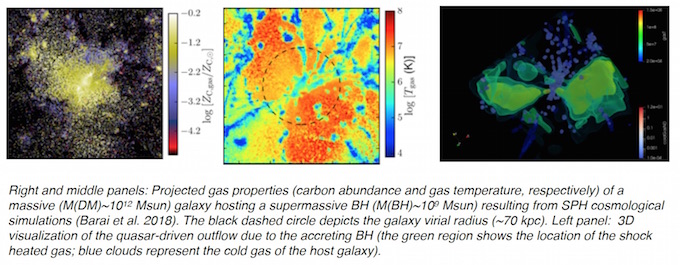1) We will use CLOUDY to compute self-consistent models of the absorption features from nuclear winds. Diagnostic tools will be developed to extract from X-ray data of local AGN the wind physical, geometrical and dynamical properties. Following [43,44] we will estimate the wind inner radius, which is a crucial parameter to disentangle the wind launching mechanism.
2) We will compare the outflow velocity, ionization parameter, temperature, pressure, predicted by different wind launching mechanisms with the energetics of the winds derived from the data.
3) We will study the link between the high-ionization outflows visible in X-rays and the lower ionization components, described in WP1, 2, 3.
4) We will first model and then search for any extended soft X-ray emission in a sample of local galaxies observed by Chandra.
Task4.2 Semi-analytic models [Lead: INAF, participants: all]
We will improve the Roma-SAM in four crucial points: a) Nuclear BH wind from task 4.1
b) Inclusion of radiative cooling for the shocked gas
c) Assumption of a realistic multiphase ISM through which the wind is expanding, using the results in WP3 on geometry, clumpiness and gas physical status
d) Assumption of realistic DM profiles
The output distributions of AGN properties (kinetic energy, outflow speed and mass, loading factor) will then be compared with observables.
Task4.3 Numerical models [Lead: SNS, participants: INAF]
We will study the multi-phase properties of outflows in z~6 quasars by exploiting cosmological simulations developed by our group ([31], see Figure below).
a) We will perform new higher-resolution (100 pc), radiative transfer simulations to quantify the amount of both molecular gas and ionized C, N, O.
b) We will compute the [CII]158m and CO emission arising from the cold and molecular gas in the quasar-driven outflow. We will produce synthetic CO and [CII] emission maps and analyze them with the same methods adopted for ALMA observations, to compare with the results from WP1.
c) We will produce [OIII]83m and [NII]122/205m synthetic maps, to be compared with ALMA observations, as well as CIV CIII], [OIII], [NII] maps to be compared with JWST observations.

